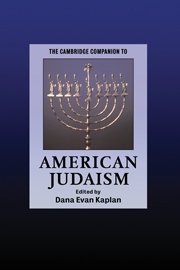Book contents
- Frontmatter
- Introduction
- Part I Historical overviews
- Part II Themes and concepts
- Section 1 Religious Culture and Institutional Practice
- Section 2 Identity and Community
- 9 The place of Judaism in American Jewish identity
- 10 The Holocaust in American Jewish life
- 11 Long-distance nationalism
- 12 Life-cycle rituals
- 13 Choosing lives
- 14 The body and sexuality in American Jewish culture
- Section 3 Living in America
- Section 4 Jewish Art in America
- Section 5 The Future
- Afterword
- Further reading
- Index
- Series list
13 - Choosing lives
Evolving gender roles in American Jewish families
from Section 2 - Identity and Community
Published online by Cambridge University Press: 28 May 2006
- Frontmatter
- Introduction
- Part I Historical overviews
- Part II Themes and concepts
- Section 1 Religious Culture and Institutional Practice
- Section 2 Identity and Community
- 9 The place of Judaism in American Jewish identity
- 10 The Holocaust in American Jewish life
- 11 Long-distance nationalism
- 12 Life-cycle rituals
- 13 Choosing lives
- 14 The body and sexuality in American Jewish culture
- Section 3 Living in America
- Section 4 Jewish Art in America
- Section 5 The Future
- Afterword
- Further reading
- Index
- Series list
Summary
Jews have often regarded themselves as being exceptionally family oriented. In historical, premodern Jewish communities, and in many contemporary traditionalist societies, the family has been the basic building block of society. Societies have encouraged men and women to marry early, stay married, and remarry in the case of divorce or widowhood. A congruence of religious values, economic necessities, and cultural and societal pressures within traditional Jewish cultures have promoted marriage as the preferable marriage status providing a productive and salutary state in adulthood. This belief or conviction makes married adults and their families central, while it marginalizes the unmarried. This essay explores the impact of revisioning gender roles within the Jewish family within three contexts: the impact on society, the impact on the family, and the impact on the individual woman and man.
Jewish law prescribes specific behaviors for all members of the family unit, and thus it plays an important part in gender role divisions. For instance, little boys are socialized into the rigors of study and public prayer, while little girls are socialized into the endless demands of family and household. This dictates that women and men should share the vast majority of behaviors prescribed through a complex network of mitzvot (commanded behaviors). Thus, before Passover, males scour rabbinic texts and sources for new interpretations of Haggadic materials to bring to the Seder table, while females scour floors, cabinets, and closets.
- Type
- Chapter
- Information
- The Cambridge Companion to American Judaism , pp. 237 - 252Publisher: Cambridge University PressPrint publication year: 2005
- 1
- Cited by

